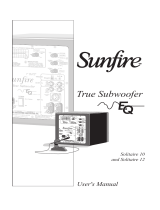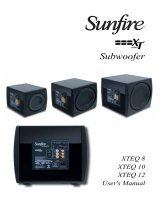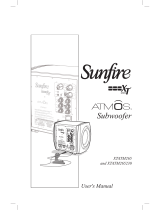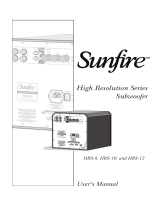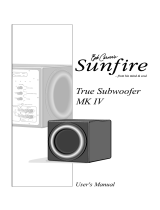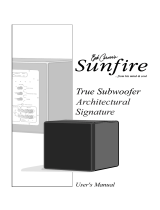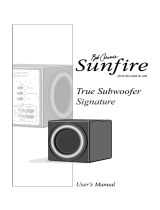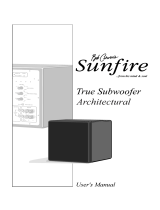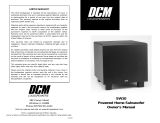Page is loading ...

DIM - STANDBY
BRIGHT - ON
True Subwoofer
DIM - STANDBY
BRIGHT -
ON
User's Manual
Signature an
d
Standard Edition

2
5SERgS-ANUAL
Safety In struc tions
1. Read In struc tions -– All the safe ty and
op er a tion instructions should be read before
the Sunfi re Com po nent is operated.
2. Retain Instructions — The safety and
operating in struc tions should be kept for
future reference.
3. Heed Warnings — All warnings on the
Com po nent and in these op er at ing in struc -
tions should be followed.
4. Follow Instructions — All operating and
other in struc tions should be followed.
5. Water and Moisture — The Compo-
nent should not be used near water - for
example, near a bathtub, wash bowl, kitchen
sink, laundry tub, in a wet base ment, or near
a swim ming pool, etc. This Component is
intended for use in Moderate climates. Do
not use in Tropical climates.
6. Ventilation — The Component should
be situated so that its location or position
does not interfere with its proper ven ti la tion.
Ensure a minimum distance of 2 inches
(5 cm) around the Component for suffi cient
ventilation. For example, the Component
should not be situated on a bed, sofa, rug,
or similar surface that may block any ven ti -
la tion; or placed in a built-in installation such
as a bookcase or cabinet that may impede
the fl ow of air. Ensure that the ventilation is
not impeded by covering the control panel
with items such as newspapers, table-cloths,
curtains, shaggy dogs, sleeping cats etc.
7. Heat and Flames — The Com po nent
should be situated away from heat sources
such as radiators, or other devices which
produce heat. Do not place naked fl ame
sources, such as lighted candles on top of,
or near the Component.
8. Power Sources — The Com po nent should
be con nect ed to a power supply only of the
type de scribed in these op er a tion in struc -
tions or as marked on the Com po nent.
9. Power Cord Protection — Power-supply
cords should be routed so that they are
not likely to be walked upon or pinched by
items placed upon or against them, paying
particular at ten tion to cords at plugs, con-
ve nience re cep tacles, and the point where
they exit the Com po nent.
10. Cleaning — The Com po nent should
be cleaned only as recommended in this
manual.
11. Non-use Pe ri ods—The pow er cord of
the Com po nent should be un plugged from
the outlet when unused for a long pe ri od
of time.
12. Ob ject and Liq uid En try — Care
should be taken so that objects do not fall
into and liquids are not spilled into the in-
side of the Com po nent. Do not expose the
Component to dripping or splashing from
liquids. Do not place objects fi lled with
liquids on top of, or near the Component.
For example, no vases, glasses of wine,
or cans of pop.
13. Damage Re quir ing Service — The
Com po nent should be serviced only by
qualifi ed service per son nel when:
A. The power-supply cord or the plug has
been dam aged; or
B. Objects have fallen, or liquid has spilled
into the Component; or
C. The Com po nent has been exposed to
rain; or
D. The Com po nent does not appear to oper-
ate normally or exhibits a marked change
in per for mance; or
E. The Component has been dropped, or its
cabinet damaged.
14. Servicing — The user should not at-
tempt to service the Component beyond
those means de scribed in this op er at ing
manual. All other ser vic ing should be
referred to qualifi ed service personnel.

3
5SERgS-ANUAL
15. To Prevent Electric Shock, do not
use this polarized plug with an extension
cord, re cep ta cle or other outlet unless the
blades can be fully inserted to prevent
blade ex po sure.
Pour préevenir les chocs électriques ne
pas utiliser cette fi che polariseé avec un
prolongateur, un prise de courant ou une
autre sortie de courant, sauf si les lames
peuvent être insérées à fond sans laisser
aucune pariie à découvert.
16. Grounding or Po lari za tion — Pre cau -
tions should be taken so that the ground-
ing or polarization means of the Com-
po nent is not defeated.
Safety Instructions.........................................2
Introduction ...................................................4
Features ........................................................4
Unpacking and Care .....................................4
Overview .......................................................5
Control Panel Features .................................6
Installation .....................................................9
Connections ................................................10
Location ......................................................11
Room Equalization Procedure ....................12
System Confi gurations ................................14
Adjusting the Controls .................................18
Specifi cations (Signature Edition) ...............19
Specifi cations (Standard Edition) ................20
Troubleshooting Guide ................................21
Limited Warranty .........................................23
Service Assistance ......................................23
Contents
To fi nd out more about this and other Sunfi re products,
please visit our website: www.sunfi re.com
This apparatus does not exceed the Class
A/Class B (which ev er is ap pli ca ble) limits
for radio noise emis sions from digital ap-
paratus as set out in the radio interference
regulations of the Canadian De part ment of
Com mu ni ca tions.
ATTENTION — Le présent appareil numéri-
que n'émet pas de bruits radioélectriques
dépassant las limites applicables aux ap-
pareils numériques de class A/de class B
(selon le cas) prescrites dans le règlement
sur le brouillage radioélectrique édicté
par les ministere des com mu ni ca tions du
Canada.
WARNING:THIS SUBWOOFER IS CAPABLE OF PRO DUC ING
VERY HIGH SOUND PRESSURE LEVELS. YOU MUST TAKE
EVERY PRECAUTION TO PROTECT YOUR HEAR ING FROM
PER MA NENT DAM AGE.

4
5SERgS-ANUAL
Your Sunfi re Subwoofer should reach
you in perfect con di tion. If you do notice
any ship ping dam age, please contact
your Sunfi re Dealer im me di ate ly.
Gently lift out the unit and remove all
the packing material. It is im por tant to
save all the packing ma te ri als and the
box in case your subwoofer ever needs
to be moved or shipped for repair.
Make sure that you keep your sales
receipt. It is the only way to establish
the duration of your Limited Warranty
and it may come in useful for insurance
pur pos es.
Please take a moment to fi ll out and
mail the Sunfi re Customer Response
card. Also read the serial num ber located
on the control panel and record it here:
Unpacking
Features
• 2,700 watt, high effi ciency amplifi er
• High gloss, dark rosewood fi nish (also
referred to as Deep Bing Cherry Lac-
quer)
• Automatic Room Equalization mode
• Measurement Microphone included
• Very low distortion
• Long throw, premium quality drivers
• Stunning output from a small cube!
• Automatic signal-sensing turn-on and
standby mode
• 12 VDC trigger input for remote turn-on
• Balanced XLR input
• Line level unbalanced inputs
• Speaker level binding post inputs
• Line level high-pass outputs
• Continuously variable phase control
• Continuously variable crossover fre-
quency adjustment, 35 to 100 Hz
• Continuously variable volume level
control
• Soft clipping circuit allows graceful
overload and prevents speaker dam age
due to clipping
• Gold-plated inputs and outputs.
Thank you for purchasing this Sunfi re
True Subwoofer EQ. We hope you enjoy
it and the music it makes as much as we
have enjoyed creating it for you.
The big breakthrough features of
the subwoofer are its uncanny track-
ing downconverter, its long throw, high
back-electromotive force driver, and its
fully automatic room equalizer. Taken
together, they provide this sub woof er with
as much bass as you could get from sev-
eral 15 inch drivers mount ed in a cabinet
the size of a small re frig er a tor.
Introduction
Care
To maintain the speaker cabinet’s fi n-
ish, fi rst unplug the power cord and then
use a soft cloth to clean the sur fac es.
If your Sunfi re Subwoofer needs ser-
vic ing, please read the Trou ble shoot ing
section on page 21. If a problem still
persists, contact your near est au tho rized
Sunfi re Dealer.
Serial Number:
Purchased from:
Date:

5
5SERgS-ANUAL
Your Sunfi re True Subwoofer EQ is
designed to give you the best possible
low-fre quen cy sound quality for your
Home Theater ex pe ri ence. It in cor po rates
a tre men dous ly powerful built-in am pli fi er
and a pair of drivers to produce tight,
fl oor-rumbling, denture-rattling bass that
you can feel as well as hear.
The subwoofer is available in two ver-
sions, and this manual covers both:
Signature Edition is a 13 inch cube, with
an output greater than 116 dB peak
SPL, 16 Hz to 100 Hz.
Standard Edition is an 11 inch cube,
with an output greater than 110 dB
peak SPL, 18 Hz to 100 Hz.
The subwoofer has an automatic
equalization system which will tailor the
subwoofer output to compensate for any
room effects. It also has a manual equal-
ization mode.
The subwoofer has an adjustable high
cut fi lter and a choice of speaker-level
or line-level inputs for easy in cor po ra tion
into existing systems, or as part of a
subwoofer/satellite speaker com bi na tion.
Controls for adjusting the volume,
crossover frequency and phase, allow
the subwoofer to be perfectly matched
to any listening environment and audio
components.
The Drivers
To have lots of bass requires moving
lots of air. Your Sunfi re Subwoofer incor-
porates two drivers that can move back
and forth ap prox i mate ly fi ve times more
than a normal sub woof er. This gives it a
lot of air moving capacity which allows for
majestic bass per for mance.
Two drivers share the acoustic output.
Sometimes one driver appears to be
moving more than the other. They both
move the same amount only when op-
erating at the limit of their ex cur sion and
power output, or when bass requirements
and music re quire ments demand maxi-
mum output from the system. Otherwise,
the power is shared between the two
drivers in a way that depends on the mo-
mentary am pli tude and the mo men tary
musical spectrum. It is normal for one or
the other to move more or less than its
mate during operation.
The Amplifi er
The large movement range of the driv-
ers creates greater air pressure inside
the box than a con ven tion al subwoofer.
There fore, the drive am pli fi er must be
much more powerful than an or di nary
subwoofer amplifi er. In fact, it has to be
so powerful, it is almost hard to believe.
The power amplifi er within your Sunfi re
Subwoofer is capable of de liv er ing over
2,700 watts into a 3.3 ohm resistor (the
driver voice coil re sis tance). When the
same full output is applied to the driver,
however, the enor mous back-elec tro -
mo tive force gen er at ed as a con se -
quence of its large motion and giant mag-
net, causes the current fl ow to be much
less than if it were a 3.3 ohm resistor. It
is this singular property of the driver that
allows the subwoofer to be ap prox i mate ly
ten times more effi cient than a subwoofer
this size would nor mal ly be.
A compressor circuit kicks in au to mat i-
cal ly if the input signal level reaches a
level that would overload the driver. This
maintains a ceiling on the output without
clip ping. If the input signal is driven even
further, a ‘soft clipping’ circuit is enabled.
This allows the subwoofer to put more
sound into the room to satiate the power
hungry user, but without distortion or
damage to the subwoofer. Thus, for ex-
plosive scenes in movies, this pro duc es
extremely high sound pressure levels
(SPL) in your room without the drivers
banging against the mechanical stops.
For more details of the subwoofer de-
sign, please call us or view our website:
www.sunfi re.com.
Overview

6
5SERgS-ANUAL
1. Volume
This control lets you match the output
level of the subwoofer to the level
of your sat el lite/main speak ers. The
subwoofer output will increase as this
control is rotated clockwise. When you
have just installed your system, turn
this down fi rst before turning on your
sub woof er. This will prevent any loud
surprises.
2. Crossover Frequency
This controls the high frequency cutoff
point. With the control set to the 100
Hz mark, the sub woof er will reproduce
fre quen cies up to 100 Hz. If the control
is set fully clockwise, the crossover is
bypassed and the subwoofer will re-
pro duce a wide frequency range. With
the control fully counter-clock wise the
sub woof er re pro duc es a narrow range,
up to 30 Hz.
Rotate the control until the bass sounds
natural. If the mid-bass sounds natural
but you want more low bass, turn this
control down a little, then turn the
Volume control up by about the same
amount. This increases the low-bass
output while leaving the mid-bass
output the same.
3. Phase Control
This control changes the relative phase
of the sub woof er with respect to your
other speakers. Use this control to help
blend the sub woof er with the rest of
your sys tem. This is accomplished by
ad just ing the control in small in cre -
ments as you listen for the most bass
at your lis ten ing position. As a fi nal trim,
readjust the Crossover Frequency and
Volume controls after the Phase has
been set.
4. Trigger Inputs
These two inputs can be used to auto-
matically turn on the subwoofer. To do
this, connect 12 VDC to either of these
terminals. Some Home Theater pre-
amplifi ers, such as the Sunfi re Theater
Grand II and III, have matching 12 VDC
Trigger outputs. When they are turned
on, the subwoofer will turn on.
5. Outputs
Line level high-pass output signals
are available at these jacks. These
outputs are active whenever a signal
is hooked up to the line level inputs
of the sub woof er. This crossover is a
Control Panel Features
DIM - STANDBY
BRIGHT - ON
1
2
3
4
5
6
7
8
10
11
15
14
13
12
9

7
5SERgS-ANUAL
passive network with a fi xed crossover
frequency of 70 Hz and a 6 dB per
octave slope.
We rec om mend using this high-pass
function with main/satellite speak ers
that are small and not designed to
reproduce low fre quen cies. If your main
speakers are capable of op er at ing full
range, then you will not need to use the
high-pass function.
To use the high-pass outputs, connect
the preamp outs on your preamp/
receiver to the subwoofer’s line level in-
puts using good quality RCA type patch
cords. Then connect a second patch
cord from the subwoofer’s outputs to
the inputs of your main amplifi er. This
will allow your main speak ers to oper-
ate at fre quen cies above 70 Hz and the
sub woof er to operate at fre quen cies
below 70 Hz (see page 16).
6. Line Level Inputs
Connect these unbalanced inputs with
RCA type patch cords to the line level
outputs of your receiver or preamp.
If your preamplifi er or receiver has a
single sub/LFE output, connect it to
the sub woof er’s left input jack (see
page 14). There is no need to use the
subwoofer’s right input jack.
If you want to run your main/satellite
speakers full range, use a “Y” adapter
at the preamplifi er outputs (see page
15). In this way, you can send the
preamplifi er’s output signal to your
main amplifi er and to the subwoofer at
the same time.
7. Balanced (XLR) Input
Use this balanced input to connect
to the balanced line-level output of a
Home Theater preamplifi er or other
source. Balanced connections offer
superior noise cancellation over unbal-
anced connections, so if your preamp
has an XLR subwoofer output, we
recommend using it.
8. Speaker Level Inputs
Under normal conditions, the preferred
connection is through the line level
inputs. If this is diffi cult or not possible
in your system, then you can use the
speaker level inputs. Also, if you ex pe -
ri ence ex ces sive noise or hum with the
line level inputs, often a simple change
to the speaker level inputs will result in
a lower back ground noise level.
Connect the speaker level inputs to the
speak er-level outputs of your am pli fi er
or receiver using speaker wire. The
binding posts can accept bare wire,
banana, dual-banana or spade con-
nec tions.
Your amplifi er or receiver MUST
have com mon grounded outputs,
or it will be dam aged if con nect ed
to the subwoofer’s speaker level
inputs.
9. Line Fuse
The subwoofer is supplied with a con-
ser va tive slow-blow type fuse to protect
the elec tron ics.
Always unplug the power cord
before inspecting or changing the
fuse. Never use a fuse with a larg-
er current rating than shown on the
markings next to the fuseholder.
10. IEC Linecord socket
The subwoofer comes with a detach-
able linecord which connects here.
US (120 VAC) MODEL: Connect
the linecord to the subwoofer before
connecting the other end to an 120
Volt, 60 Hz AC outlet. The outlet must
have a cir cuit rating of 8 amps or more
(a typical home circuit is rated at 15
amps).
Never plug the US (120 VAC)
Model subwoofer directly into
220-240 Volts AC as this will cause
cat a stroph ic circuit failure.

8
5SERgS-ANUAL
Control Panel Features continued
EURO (230 VAC) MODEL: Connect
the linecord to the subwoofer before
connecting the other end to a 230 Volt,
50/60 Hz AC outlet. The outlet must
have a cir cuit rating of 8 amps or more.
Never plug the Euro (230 VAC)
model subwoofer directly into 120-
130 Volts AC.
11. Power Switch
The power switch is a CE requirement
for international shipments. Leave it
switched on at all times for normal
operation.
After a period of inactivity (i.e. with
no input signal), the subwoofer will
automatically turn itself to Standby
mode, where it is effectively off. It can
however, turn back on automatically
when an input signal is applied, if a
12 VDC trigger voltage is applied to the
Trigger inputs, or if the Start button is
pressed.
12.Start button
Press this once to enter the Auto EQ
mode (if the sub is out of Standby
mode). Press and hold down for
several seconds to enter the Manual
EQ mode. See page 12 for more
details on this and the following EQ
controls.
13.Microphone Input
This is where you plug in the supplied
linear measurement microphone when
you want to use the Auto EQ mode.
14.LED display
These LEDs are used during the Auto
EQ and Manual EQ procedures.
15.Equalizer Authority
This control's primary purpose is to
adjust the EQ Authority. During normal
listening, you can adjust the overall EQ
from none (ccw, 0%), to fully equalized
(cw, 100%). For example, if your fi rst
band has a 6 dB boost, setting this
control to 50% would make it boost
only 3 dB.
This control is also used during the
Manual EQ mode to adjust each of the
four internal EQ bands, and allow you
to add "color" to the sound as desired.
DIM - STANDBY
BRIGHT - ON
11
15
14
13
12

9
5SERgS-ANUAL
Installation
Observe the following general pre cau -
tions and read the safety in struc tions on
pages 2 and 3 before using your Sunfi re
Subwoofer.
• Never open the cabinet or remove
the metal control panel as this
might result in an electrical shock to
you, or dam age to the unit.
• Protect it from prolonged ex po sure
to direct sunlight and other direct
sources of heat, such as heating
vents and ra di a tors.
• To prevent fi re or shock, do not
expose the unit to rain or moisture.
If fl uid or a foreign object should
enter the unit, immediately turn off
the power and contact your Sunfi re
Dealer.
• Avoid excessive exposure to
extreme cold or dust.
• Do not place heavy objects on top
of the unit.
• Do not place the subwoofer with its
control panel against the fl oor.
• If you wish to place your subwoofer
so the drivers face the fl oor and
ceiling, thereby moving up and
down, use at least 1-1/2 inch high
spikes or feet for support. They
may be attached either with screws
or self-stick backing. This ar range -
ment will impart substantial house
and fl oor shaking motion.
• Four extra heavy, shock absorbing
rubber mounting feet have been
included. If your subwoofer tends
to wander about slightly while in
use, place these feet just inside
the existing feet positions. These
shock absorbing mounts will let
the subwoofer rock freely, thereby
absorbing low frequency rocking
energy, allowing it to adhere solidly
to the fl oor.
• To move the subwoofer along the
fl oor, rotate it onto one edge onto a
plastic sheet or bag, and it will slide
along easier.
Heat rise
• Allow adequate ventilation around
the metal control panel of the
subwoofer.
• Do not let anything come into
contact with the panel and keep
at least two inches away from any
walls.
The metal control plate serves as the
am pli fi er heat sink and also as a conduit
to remove internal heat to the outside
and into the atmosphere. It can reach
tem per a tures of 60 degrees C, which
will feel hot to the touch, using nerves of
fl esh and blood as tem per a ture sen-
sors. As uncomfortable as it may feel, 60
degrees C cannot burn you, and in fact is
almost cool to copper, silicon, steel, and
aluminum, the materials from which your
subwoofer is con struct ed.
AC Power Considerations
Ensure that the unit is plugged into an
outlet capable of supplying the correct
voltage specifi ed for your model.
Unplug your subwoofer’s power cord
from the electrical outlet if it will be left
unused for a long period of time.
Route the power-supply cord so it is not
likely to be walked on or pinched by items
placed upon or against it, es pe cial ly at
plugs, con ve nience re cep ta cles, and the
point where it exits from the unit.
Magnetic Fields
We recommend that you place your
subwoofer further than two feet away
from your TV, VCR, tape deck or com-
puter, so the speak er’s magnet won’t
distort the colors of your TV picture or
erase your video tapes, audio tapes or
computer discs.

10
5SERgS-ANUAL
Please consider the following when set-
ting up your new system :
• Before making or changing any
connec tions, ALWAYS make sure
that the subwoofer and your other
components are turned OFF. Also
turn down the volume control of the
sub woof er and your pream pli fi er or
receiver.
• This diagram shows all the low
power com po nents sharing a power
strip which is con nect ed to the same
out let used by the amplifi er.
• The sub woof er is con nect ed to an
out let on the same cir cuit break er,
pro vid ed that the total sys tem
cur rent draw does not exceed the
breaker current rating.
• This arrangement will reduce the
pos si bil i ty of an audible hum in your
system caused by a ground loop.
• Whenever possible, keep the
power cords away from the signal
cables or speaker wires to pre vent
any hum or in ter fer ence being
heard in the speak ers.
• Choose reliable, high quality in ter -
con nect cables, also called patch
cords or RCA cables. They should
be fully shield ed and as short as
pos si ble for the job. The longest
cable in your system will likely be to
the sub woof er, so choose a good
quality brand.
• Some patch cords can be a very
tight fi t and there is usually a
preferred method of getting them
off. Some have to be re moved with
a twisting action. Be gentle or you
may dam age the jacks of the sub-
woof er or your other com po nents.
Speaker Level connections
• The subwoofer’s speaker level
inputs can accept speaker wires
with banana, dual-banana, bare
wire or spade terminals. If you have
banana type con nec tors on your
speaker wire, make sure that you
tighten the binding posts before
inserting.
• Make sure that the negative
speaker wires never touch the posi-
tive wires as this will short out and
possibly damage your amplifi er or
receiver.
The subwoofer’s two negative
posts are joined in ter nal ly (com-
mon-ground ed). Your am pli fi er
must also be internally common-
grounded or you cannot use this
connection. Contact the man u fac -
tur er of your amplifi er to make sure
its outputs are common grounded.
Tape Deck
DVD
Preamplifier
Power strip
Subwoofer
Amplifier
A
C outlets on the same circuit breaker
Connections

11
5SERgS-ANUAL
Your subwoofer is designed to be
placed in a corner and this will produce
optimum performance.
#1 is very good positioning.
#2 is also excellent but may shake
the back wall too much and cause
things on or along the wall to rattle
too much. If this occurs, use the #3
position:
#3 Move the subwoofer ap prox i mate ly
three feet away from the right wall
and place it along the back wall
as shown. This will substantially
reduce the rattling of the back wall
and will still pres sur ize the room
with lots of bass.
Ex per i ment with at least two corners
and decide which is the best, or you can
try the following procedure:
1. Start by placing the subwoofer right
on the seat of your favorite couch
or easy chair. Take care to position
it so it is not likely to fall off. (This
method may seem a bit odd, but it
is based on principles of acoustic
physics.)
2. If you are using the subwoofer as
part of a Home Theater system,
you can either run a calibration
test (noise) signal through the
subwoofer, or simply plug the
analog outputs of a CD player di-
rectly into the subwoofer’s line level
inputs. Turn down the subwoofer's
volume level before turning on the
CD, then play some of your favorite
music samples with heavy bass.
3. Walk around the room, listening,
and stand in all the positions where
Location
you might be able to place the
subwoofer. Try crouching down,
and try the corners. Find the place
where the subwoofer's bass output
sounds the loudest.
4. Shut things down and install the
subwoofer in this position. Make
sure the control panel is not touch-
ing anything, and that it can receive
good ventilation.
Although low frequencies are non-di-
rec tion al, factors such as room re fl ec -
tions, standing waves, resonance and ab-
sorp tion will strongly affect your subwoof-
er’s per for mance. Moving the subwoofer
from one location to another can have a
major effect on the bass response.
The Auto EQ mode will let you adjust
for the room effects, but you should fi nd
the best location fi rst.
Remember to keep the subwoofer
at least two or three feet away from
any TV screen, computer, VCR or
mag net ic tapes and discs. This will
reduce the chance of the magnetic fi elds
upsetting the TV screen or erasing your
magnetic media.
Using Two Subwoofers
If you wish to use two subwoofers, the
sound output will double (an increase of
6 dB). Locate the subwoofers with one
in each corner and ex per i ment with the
location and phase control to achieve the
best bass response.
Always drive each subwoofer through
the Left/Mon input even though you are
driving one subwoofer with a right chan-
nel drive and the other with a left channel
drive. If your pream pli fi er has a single
sub/LFE output, use a Y cable to split it
into two outputs.

12
5SERgS-ANUAL
D
I
M
- S
T
A
N
D
B
Y
B
R
IG
H
T
-
O
N
Subwoofer performance is greatly af-
fected by the room in which it is situated,
and the positioning within the room. The
room effects will boost and cut the output
levels reaching your listening position.
This gives a "Room EQ" effect which can
often be far from wonderful.
The Sunfi re True Sub EQ can automati-
cally adjust for the effects of Room EQ. It
measures the actual frequency response
using the supplied measurement micro-
phone. Then it automatically compen-
sates for peaks or dips and smooths out
the response.
For best results it is recommended that
the subwoofer crossover in your receiver
or processor be set to its maximum set-
ting (or “bypass”). This ensures that the
subwoofer will be properly matched to the
rest of the speakers in your system.
The following procedure will help you
start the automatic equalization:
Automatic EQ Mode
1. Install the True Sub EQ in the best loca-
tion you can fi nd (see previous page).
2. The calibration must be done while the
listening room is quiet. Please turn off
any noisy machinery, including heating
or cooling systems during this process.
Have the kids play in the backyard and
give the dog a treat to have him stop
barking. A small amount of noise, such
as quiet talking or whispering, is OK.
Room Equalization Procedure
3. Place the microphone in the listening
position (on the couch, for example),
pointing in the direction you’ll normally
be facing while listening to your system.
Only use the microphone supplied by
Sunfi re.
4. Plug the microphone into the subwoof-
er's microphone jack.
5. Set these controls:
• Volume to 0 dB.
• Crossover to "Bypass."
• Phase to "Normal."
• Equalizer Authority to "Normal"
6. Turn on the subwoofer AC power switch
and press the Start button to go from
standby to play mode. The yellow LEDs
should light up. Press Start again to start
the calibration.
7. The subwoofer will generate a test tone
sweep, slowly increasing up the fre-
quency scale; the microphone will take
measurements of the sound arriving at
your listening position. The LEDs will
fl ash randomly for a while, then the pairs
will gradually glow constantly as each
band is measured. This sequence will
repeat twice until the measurements are
complete. The LEDs will all blink once
and stay on, and the test tones will stop.
If you fi nd that the fi rst test tone plays
louder and louder, and never leaves the
fi rst band, then either the microphone is
too far away from the subwoofer, or it is
not plugged in correctly.
8. The procedure may take several
minutes. Do not make any loud noise
during this process, as it may affect the
accuracy and/or make it take longer.

13
5SERgS-ANUAL
9. The sub automatically calculates the
best equalization, based on the mea-
sured frequency response at your listen-
ing position. This will be saved, before
returning to the normal listening mode.
10. In normal listening, you can adjust the
overall effect of the saved EQ settings
with the Equalizer Authority control.
Normally you would turn it to 100% for
full equalization. You can turn it to 0%
to judge the effect of no equalization, or
vary it to suit your taste.
11. Repeat the Auto EQ procedure if you
change the location of the subwoofer, or
if you rearrange your furniture.
Manual EQ Mode
This mode allows you to manually
adjust the room equalization to suit your
taste. Some rooms may sound fl at or life-
less without a touch of color to the sound.
The subwoofer has four EQ bands,
each represented by two yellow LEDs.
Each band is fi xed in frequency and
bandwidth, but each can be adjusted in
volume level using the Equalizer Author-
ity control during the Manual equalization
mode.
This is similar to
having sliders on
a 4-band graphic
equalizer. except the
settings for each band
are stored digitally.
The subwoofer saves the setting of the
Equalizer Authority control for each band,
so adjusting it for one band does not alter
the adjustment for the other bands.
First, you should follow the Automatic
EQ procedure, so the subwoofer will
adjust for the room effects. Then follow
this manual procedure if you think the
equalization might still need a tweak:
1. Set these controls:
• Volume to 0 dB.
• Crossover to "Bypass."
• Phase to "Normal."
• Equalizer Authority to "50%"
2. Turn on the subwoofer AC power switch.
3. Press and hold down the Start button
for several seconds, until the fi rst pair of
yellow LEDs light up.
4. A low frequency test tone will sound to
help you adjust the lowest band.
5. Adjust the volume by turning the Equal-
izer Authority control (or press Start to
skip and move on to the next band).
You will have to sit back in your listening
position each time to listen for the effect,
or seek the help of a loved one or kind
friend to turn the control while you listen.
6. Press the Start button to move on to the
next band, and then adjust the Equalizer
Authority control as needed. When you
reach the last band, the next press will
bring up the fi rst band again.
7. When all bands have been equalized to
your satisfaction, press and hold down
the Start button for several seconds
until all the yellow LEDS come on, and
the test tone turns off. The Equalizer
Authority settings will be saved for each
band. and the subwoofer will return to its
normal listening mode.
8. Use the Equalizer Authority to adjust the
effects level of your equalization.
Resetting the EQ
• Turn off the subwoofer using the AC
power switch.
• Hold down the Start button and turn on
the AC power switch.
• Keep the Start button held down for 10
seconds while the yellow LEDs fl ash.
• When the LEDS go out, the EQ is reset
to the fl at factory setting.

14
DIM - STANDBY
BRIGHT - ON
PREAMPLIFIER
MAIN
OUTPUTS
R
SUB/LFE OUT
R
L
L
AMPLIFIER
INPUTS
TO FRONT SPEAKERS
5SERgS-ANUAL
System Confi gurations
The following pages show some typical
con nec tions that you might make in your
in stal la tion. They show how the inputs
and outputs of the Sunfi re Subwoofer
are con nected to your pream pli fi er or
receiver.
If your preamplifi er has a
subwoofer output (often labeled LFE
for Low Fre quen cy Ef fects), it can be
con nect ed to the sub woof er’s Left
(Mono) input as shown. This is the
simplest and rec om mend ed con-
nection. A receiver with a sub/LFE
output can be con nect ed in the
same way.
The sub woof er will play the low
frequency range and the other
speakers will play the frequency
range delivered to them by your
amplifi er.
If you have a Home
Theater pream pli fi er,
it may have an in de -
pen dent subwoofer vol-
ume control. Make sure
this is correctly ad just ed,
and that the Sunfi re
Subwoofer’s cross over
frequency is set to 100
Hz. This is by no means
an iron-clad rule, rather it
is a good starting point.
(See the cross over fre-
quency control details on
page 6 and ad just ments
on page 18).
You can set the sub woof er’s Vol-
ume control to 0 dB, and then use the
preamplifi er’s sub woof er level control for
normal and routine ad just ments.
Connections to a preamplifi er’s subwoofer output

15
5SERgS-ANUAL
If your preamplifi er does not
have a sub/LFE output, you can
use “Y” cables to send its main
outputs to both the sub woof er and
your am pli fi er.
The subwoofer will play the low
frequency range and your front
speak ers will play the full range.
Although bass is com mon ly dis-
trib ut ed evenly between left and
right chan nels (L+R bass), movie
soundtracks often contain dif-
ferential (L-R) bass. The opening
scene in “Top Gun”, for example,
has loads of L-R bass in for -
ma tion. If this is not
preserved, the bass
in these scenes
sounds anemic. The
Sunfi re Subwoofer
utilizes dif fer en tial
gain on the left and
right inputs to retain
both the L+R and
L-R in for ma tion.
There fore, sys tems
which do not have a
dedicated sub/LFE
output should use
both the left and the
right inputs as shown, for the great est
bass impact.
An alternative connection method
without using Y cables is shown on the
next page.
If your preamp/receiver has a dedi-
cated sub/LFE output, then only the Left
(Mono) input is used, as shown on the
previous page.
Connections to a preamplifi er using Y cables
DIM
- S
TAN
DBY
BRIGH
T - O
N
PREAMPLIFIER
MAIN
OUTPUTS
L
SUB/LFE OUT
L
R
R
AMPLIFIER
INPUTS
TO FRONT SPEAKERS

16
5SERgS-ANUAL
If you are using a pream pli fi er
which does not have a sub/LFE
output, you can send its left
and right front output into the
sub woof er’s Line Level inputs
and then connect the sub woof -
er’s High-Pass outputs to the
inputs of your amplifi er.
The subwoofer will play
the low frequencies and your
amplifi er and front speakers
will play the fre quen cy range
above the subwoofer’s fi xed
high-pass crossover point.
The signals coming
out of the subwoof-
er’s high-pass
outputs are not
affected by any of
the controls. They
are just a copy of
the signals going
in except that the
low bass is fi ltered
out. This uses
the sub woof er’s
passive crossover
network, rather than
the active network
and con trols.
This is an excellent method if your
speakers are small satellites or mini-
monitors, and/or your power amplifi er is
of limited power, such as a tube amp.
Using the line level high-pass outputs
DIM - STANDBY
BRIGHT - ON
PREAMPLIFIER
MAIN
OUTPUTS
L
L
R
R
AMPLIFIER
INPUTS
TO FRONT SPEAKERS

17
5SERgS-ANUAL
If you are using a receiver
which does not have a sub-
woof er output or line level
outputs (pre-outs), you can
connect its speak er outputs
to the subwoofer’s speaker-
level inputs. The front speak ers
can still be con nect ed to your
receiver.
The subwoofer’s internal
amplifi er supplies the power to
reproduce the low fre quen cy
range. It receives a sample of
the signal going to your front
speakers. (An in sig nifi cant frac-
tion of your receiver’s power is
trans ferred to the subwoofer).
There is no
need to use the
speaker level
inputs if you are
using a sep a rate
am pli fi er and pre-
am pli fi er. Such
systems are
best con nect ed
using the line level
inputs as shown in the pre vi ous
diagrams.
If you are using the line
level inputs and there is a
excessive amount of noise
or hum present, using the
speak er level inputs may yield a
lower background noise level.
Your receiver MUST have com mon
grounded outputs, or it will be dam-
aged if con nect ed to the sub woof -
er’s speaker level inputs.
Using the speaker level inputs
D
IM
- STAN
DB
Y
B
RIG
HT - O
N
TO FRONT SPEAKERS
L
R
RECEIVER
MAIN
OUTPUTS

18
5SERgS-ANUAL
There are two main methods for adjust-
ing the level, crossover frequency and
phase of the Sunfi re Subwoofer to match
a sys tem:
• Bob Carver’s preferred method:
By listening and making the
adjustments to suit your taste.
• Laboratory method: By measuring
the output and adjusting for a fl at
frequency response.
Excellent results can be obtained if you
make the adjustments based on simply
listening. This is Sunfi re’s preferred meth-
od as it allows the system to be voiced
based on what sounds the best, whereas
lab o ra to ry-fl at frequency response can
often be clinical and less than ex cit ing.
The following procedure is for those
who prefer a more methodical and scien-
tifi c ap proach. This excerpt is from “The
Audio Critic,” issue 24, page 31, written
by con trib ut ing editor David Rich, and is
reprinted here with their kind permission.
You will need a test CD with low-fre-
quen cy warble tones, and a sound pres-
sure-level meter. The Radio Shack
®
SPL
meter will do fi ne, as will the Stereophile
®
test CD.
“Step 1. Disconnect the subwoofer and
run the main speaker with a tone in its
pass band (80-100Hz). Measure the level.
Step 2. Disconnect the main speaker
and reconnect the subwoofer. Set the
sub woof er to its highest crossover
frequency. Set the level control of the
subwoofer to give the same sound pres-
sure level with the same tone you used
in Step 1.
Step 3. With both the subwoofer and
the main speaker connected, measure
the level of the tones at the available
fre quen cies. Because the crossover
is set too high, you will have a peaked
response. Adjust the cross over control to
get the smoothest response.
Adjusting the controls
Step 4. Use the phase control to make
the response even smoother. It has its
biggest effect at the crossover fre quen cy.
You can iterate between the crossover
and the phase controls. Keep your hands
off the level control! It was set correctly
in step 2.
Step 5. Listen to the subwoofer.
Resist all temptations to turn up the level
control. Play something with really deep
bass to confi rm that your subwoofer is
working.”
Control settings
Use this drawing to record some of
your favorite settings.

19
5SERgS-ANUAL
Specifi cations (Signature Edition)
Amplifi er Output
2,700 watts rms (3.3 Ω impedance)
High Cut Filter
30 Hz - 100 Hz adjustable, with a
"Bypass" position.
Frequency Response
16 Hz - 100 Hz
Power Line Voltage
US model
120 VAC 50/60 Hz
International model
230 VAC 50/60 Hz
Dimensions
13" x 13" x 13"
Weight
53 lbs
Finish
High gloss, dark rosewood fi nish (also
referred to as Deep Bing Cherry Lac-
quer).
Line Power Consumption:
800 watts average, at maximum continu-
ous output. 8 watts at idle.
2,700 watts peak, time limited basis
Output Levels:
Greater than 116 dB peak SPL (includes
room gain) from 16 Hz to 100 Hz. Mea-
surement is one meter, anechoic.
A typical Sunfi re subwoofer can be
ex pect ed to ‘best’ its spec i fi ed minimum
peak SPL by several decibels.
Total Harmonic Distortion
Typically less than 1/10 of the fun da -
men tal between 18 to 80 Hz.
Input Sensitivity (full output):
250 mVrms from left input with volume
control at 0 dB, 60 mVrms volume con-
trol fully clockwise
*
0.75 Vrms from right input with volume
control at 0 dB, 200 mVrms volume
control fully clockwise
*
Input Impedance:
30 kΩ for Line-Level inputs
56 kΩ for Hi-Level inputs
40 kΩ for XLR input, each leg balanced
to ground
XLR Input
Pin 1 Ground
Pin 2 Positive
Pin 3 Negative
Driver: 12 inch
Extra large magnet and long throw
me chan i cal design yield very high
back-emf. The result is ex traor di nar i ly
high operating effi ciency – that is, more
acoustic output for each watt of input.
Internal System Gain:
50 dB from left input jack to speaker
with volume control at 0 dB, 62 dB with
control fully clockwise
*
40 dB from right input jack to speaker
with volume control at 0 dB, 52 dB with
control fully clockwise
*
*
The Sunfi re True Sub woof er utilizes
differential gain on the left and right
inputs to retain both L+R and L-R
information.
12 VDC Trigger Input
Input voltage range: 5 -18 VDC
Impedance: approx 600 Ω
(20 mA @ 12 V)
Removable terminal block, and one 1/8”
Mono minijack, tip positive.

20
5SERgS-ANUAL
Amplifi er Output
2,700 watts rms (3.3Ω impedance)
High Cut Filter
35 Hz - 100 Hz adjustable, with a "By-
pass" position.
Frequency Response
18 Hz - 100 Hz
Power Line Voltage
US model
120 VAC 50/60 Hz
International model
230 VAC 50/60 Hz
Dimensions
11" x 11" x 11"
Weight
48 lbs
Finish
High gloss, dark rosewood fi nish (also
referred to as Deep Bing Cherry Lac-
quer).
Line Power Consumption:
600 watts average, at maximum continu-
ous output. 8 watts at idle.
2,700 watts peak, time limited basis
Output Levels:
Greater than 110 dB peak SPL (includes
room gain) from 18 Hz to 80 Hz. Mea-
surement is one meter, anechoic.
A typical Sunfi re subwoofer can be
ex pect ed to ‘best’ its spec i fi ed minimum
peak SPL by several decibels.
Total Harmonic Distortion
Typically less than 1/10 of the fun da -
men tal between 18 to 80 Hz.
Input Sensitivity (full output):
250 mVrms from left input with volume
control at 0 dB, 60 mVrms volume con-
trol fully clockwise
*
0.75 Vrms from right input with volume
control at 0 dB, 200 mVrms volume
control fully clockwise
*
Input Impedance:
30 kΩ for Line-Level inputs
56 kΩ for Hi-Level inputs
40 kΩ for XLR input, each leg balanced
to ground
XLR Input
Pin 1 Ground
Pin 2 Positive
Pin 3 Negative
Driver: 10 inch
Extra large magnet and long throw
me chan i cal design yield very high
back-emf. The result is ex traor di nar i ly
high operating effi ciency – that is, more
acoustic output for each watt of input.
Internal System Gain:
50 dB from left input jack to speaker
with volume control at 0 dB, 62 dB with
control fully clockwise
*
40 dB from right input jack to speaker
with volume control at 0 dB, 52 dB with
control fully clockwise
*
*
The Sunfi re True Sub woof er utilizes
differential gain on the left and right
inputs to retain both L+R and L-R
information.
12 VDC Trigger Input
Input voltage range: 5 -18 VDC
Impedance: approx 600 Ω
(20 mA @ 12 V)
Removable terminal block, and one 1/8”
Mono minijack, tip positive.
Specifi cations (Standard Edition)
© 2006 Sunfi re Corporation.
All rights reserved. Sunfi re Corporation
re serves the right to improve its products
at any time. Therefore, specifi cations are
subject to change without notice.
Manual 913-103-00 Rev D
/
